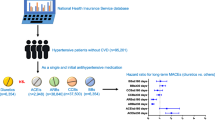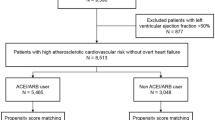Abstract
Objective
We investigated the association between the use of ACEi, ARB, or non-renin–angiotensin–aldosterone system inhibitors (non-RASi) and incident cardiovascular events in an unselected nationwide hypertension cohort.
Methods
The information regarding 2,025,849 patients who underwent general health checkup between 2010 and 2011 and were on antihypertensive medication was collected. Patients were allocated into ACEi, ARB, and non-RASi groups and followed until 2019. The outcomes of interest were myocardial infarction (MI), ischemic stroke (IS), atrial fibrillation (AF), heart failure (HF), and all-cause deaths.
Results
Patients on ACEi and ARB showed unfavorable baseline characteristics compared to those on non-RASi. After adjusting for covariates, the ACEi group showed lower risks of MI, AF, and all-cause deaths (HR (95% CI): 0.94 (0.89–0.99), 0.96 (0.92–1.00), and 0.93 (0.90–0.96), respectively), but similar risks of IS and HF (0.97 (0.92–1.01) and 1.03 (1.00–1.06), respectively), compared to the non-RASi group. Likewise, the ARB group showed decreased risks of MI, IS, AF, HF, and all-cause deaths (HR (95% CI): 0.93 (0.91–0.95), 0.88 (0.86–0.90), 0.86 (0.85–0.88), 0.94 (0.93–0.96), and 0.84 (0.83–0.85)), compared to the non-RASi group. Sensitivity analysis of patients taking a single antihypertensive medication showed similar results. In the propensity score matching (PSM) cohort, the ARB group showed similar risks of MI and decreased risks of IS, AF, HF, and all-cause deaths compared to the ACEi group.
Conclusions
ACEi and ARB users were associated with decreased risks of MI, IS, AF, HF, and all-cause deaths, compared to non-RASi users.
Graphical Abstract



Similar content being viewed by others
References
Collaboration NCDRF (2021) Worldwide trends in hypertension prevalence and progress in treatment and control from 1990 to 2019: a pooled analysis of 1201 population-representative studies with 104 million participants. Lancet 398(10304):957–980
Collaborators GBDRF (2018) Global, regional, and national comparative risk assessment of 84 behavioural, environmental and occupational, and metabolic risks or clusters of risks for 195 countries and territories, 1990–2017: a systematic analysis for the global burden of disease study 2017. Lancet 392:1923–1994
Mills KT, Bundy JD, Kelly TN, Reed JE, Kearney PM, Reynolds K, Chen J, He J (2016) Global disparities of hypertension prevalence and control: a systematic analysis of population-based studies from 90 countries. Circulation 134:441–450
Zhou B, Perel P, Mensah GA, Ezzati M (2021) Global epidemiology, health burden and effective interventions for elevated blood pressure and hypertension. Nat Rev Cardiol 18(11):785–802
Whelton PK, Carey RM, Aronow WS, Casey DE Jr, Collins KJ, Dennison Himmelfarb C, DePalma SM, Gidding S, Jamerson KA, Jones DW, MacLaughlin EJ, Muntner P, Ovbiagele B, Smith SC Jr, Spencer CC, Stafford RS, Taler SJ, Thomas RJ, Williams KA Sr, Williamson JD, Wright JT Jr (2018) 2017 ACC/AHA/AAPA/ABC/ACPM/AGS/APhA/ASH/ASPC/NMA/ PCNA guideline for the prevention, detection, evaluation, and management of high blood pressure in adults: a report of the American college of cardiology/American heart association task force on clinical practice guidelines. J Am Coll Cardiol 71:e127–e248
Williams B, Mancia G, Spiering W, Agabiti Rosei E, Azizi M, Burnier M, Clement DL, Coca A, de Simone G, Dominiczak A, Kahan T, Mahfoud F, Redon J, Ruilope L, Zanchetti A, Kerins M, Kjeldsen SE, Kreutz R, Laurent S, Lip GYH, McManus R, Narkiewicz K, Ruschitzka F, Schmieder RE, Shlyakhto E, Tsioufis C, Aboyans V, Desormais I, Group ESCSD (2018) 2018 ESC/ESH guidelines for the management of arterial hypertension. Eur Heart J 39:3021–3104
Unger T, Borghi C, Charchar F, Khan NA, Poulter NR, Prabhakaran D, Ramirez A, Schlaich M, Stergiou GS, Tomaszewski M, Wainford RD, Williams B, Schutte AE (2020) 2020 International society of hypertension global hypertension practice guidelines. Hypertension 75:1334–1357
Collaboration NCDRF (2017) Worldwide trends in blood pressure from 1975 to 2015: a pooled analysis of 1479 population-based measurement studies with 19.1 million participants. Lancet 389:37–55
Mills KT, Stefanescu A, He J (2020) The global epidemiology of hypertension. Nat Rev Nephrol 16:223–237
Heran BS, Wong MM, Heran IK, Wright JM (2008) Blood pressure lowering efficacy of angiotensin converting enzyme (ACE) inhibitors for primary hypertension. Cochrane Database Syst Rev. https://doi.org/10.1002/14651858.CD003823.pub2
Heran BS, Wong MM, Heran IK, Wright JM (2008) Blood pressure lowering efficacy of angiotensin receptor blockers for primary hypertension. Cochrane Database Syst Rev. https://doi.org/10.1002/14651858.CD003822.pub2
Li EC, Heran BS, Wright JM (2014) Angiotensin converting enzyme (ACE) inhibitors versus angiotensin receptor blockers for primary hypertension. Cochrane Database Syst Rev 8:CD009096
Julius S, Kjeldsen SE, Weber M, Brunner HR, Ekman S, Hansson L, Hua T, Laragh J, McInnes GT, Mitchell L, Plat F, Schork A, Smith B, Zanchetti A, Group Vt (2004) Outcomes in hypertensive patients at high cardiovascular risk treated with regimens based on valsartan or amlodipine: the VALUE randomised trial. Lancet 363:2022–2031
Bangalore S, Fakheri R, Toklu B, Ogedegbe G, Weintraub H, Messerli FH (2016) Angiotensin-converting enzyme inhibitors or angiotensin receptor blockers in patients without heart failure? Insights from 254,301 patients from randomized trials. Mayo Clin Proc 91:51–60
Strauss MH, Hall AS (2006) Angiotensin receptor blockers may increase risk of myocardial infarction: unraveling the ARB-MI paradox. Circulation 114:838–854
Gu Q, Burt VL, Dillon CF, Yoon S (2012) Trends in antihypertensive medication use and blood pressure control among United States adults with hypertension: the national health and nutrition examination survey, 2001 to 2010. Circulation 126:2105–2114
Sarganas G, Knopf H, Grams D, Neuhauser HK (2016) Trends in antihypertensive medication use and blood pressure control among adults with hypertension in Germany. Am J Hypertens 29:104–113
Messerli FH, Bangalore S (2017) Angiotensin receptor blockers reduce cardiovascular events, including the risk of myocardial infarction. Circulation 135:2085–2087
Strauss MH, Hall AS (2017) Angiotensin receptor blockers do not reduce risk of myocardial infarction, cardiovascular death, or total mortality: further evidence for the ARB-MI paradox. Circulation 135:2088–2090
Ettehad D, Emdin CA, Kiran A, Anderson SG, Callender T, Emberson J, Chalmers J, Rodgers A, Rahimi K (2016) Blood pressure lowering for prevention of cardiovascular disease and death: a systematic review and meta-analysis. Lancet 387:957–967
Emdin CA, Rahimi K, Neal B, Callender T, Perkovic V, Patel A (2015) Blood pressure lowering in type 2 diabetes: a systematic review and meta-analysis. JAMA 313:603–615
Jussil H, Chaimani A, Carlberg B, Brunstrom M (2021) Comparative efficacy and acceptability of different antihypertensive drug classes for cardiovascular disease prevention: protocol for a systematic review and network meta-analysis. BMJ Open 11:e044302
Park CS, Choi YJ, Rhee TM, Lee HJ, Lee HS, Park JB, Kim YJ, Han KD, Kim HK (2022) U-Shaped associations between body weight changes and major cardiovascular events in type 2 diabetes mellitus: a longitudinal follow-up study of a nationwide cohort of over 1.5 million. Diabetes Care 45:1239–1246
Park JB, Kim DH, Lee H, Hwang IC, Yoon YE, Park HE, Choi SY, Kim YJ, Cho GY, Han K, Ommen SR, Kim HK (2020) Obesity and metabolic health status are determinants for the clinical expression of hypertrophic cardiomyopathy. Eur J Prev Cardiol 27:1849–1857
Choi YJ, Kim B, Rhee TM, Lee HJ, Lee H, Park JB, Lee SP, Han KD, Kim YJ, Kim HK (2022) Augmented risk of ischemic stroke in hypertrophic cardiomyopathy patients without documented atrial fibrillation. Sci Rep 12:15785
Choi EK (2020) Cardiovascular research using the Korean national health information database. Korean Circ J 50:754–772
Lee SR, Park CS, Choi EK, Ahn HJ, Han KD, Oh S, Lip GYH (2021) Hypertension burden and the risk of new-onset atrial fibrillation: a nationwide population-based study. Hypertension 77:919–928
Park CS, Han KD, Choi EK, Kim DH, Lee HJ, Lee SR, Oh S (2021) Lifestyle is associated with atrial fibrillation development in patients with type 2 diabetes mellitus. Sci Rep 11:4676
Heart Outcomes Prevention Evaluation Study I, Yusuf S, Sleight P, Pogue J, Bosch J, Davies R, Dagenais G (2000) Effects of an angiotensin-converting-enzyme inhibitor, ramipril, on cardiovascular events in high-risk patients. N Engl J Med 342:145–153
Demers C, McMurray JJ, Swedberg K, Pfeffer MA, Granger CB, Olofsson B, McKelvie RS, Ostergren J, Michelson EL, Johansson PA, Wang D, Yusuf S, Investigators C (2005) Impact of candesartan on nonfatal myocardial infarction and cardiovascular death in patients with heart failure. JAMA 294:1794–1798
Pfeffer MA, McMurray JJ, Velazquez EJ, Rouleau JL, Kober L, Maggioni AP, Solomon SD, Swedberg K, Van de Werf F, White H, Leimberger JD, Henis M, Edwards S, Zelenkofske S, Sellers MA, Califf RM, Valsartan in Acute Myocardial Infarction Trial I (2003) Valsartan, captopril, or both in myocardial infarction complicated by heart failure, left ventricular dysfunction, or both. N Engl J Med 349:1893–1906
Messerli FH, Bangalore S, Bavishi C, Rimoldi SF (2018) Angiotensin-converting enzyme inhibitors in hypertension: to use or not to use? J Am Coll Cardiol 71:1474–1482
Weintraub WS (2017) Perspective on trends in statin use. JAMA Cardiol 2:11–12
Fang MC, Coca Perraillon M, Ghosh K, Cutler DM, Rosen AB (2014) Trends in stroke rates, risk, and outcomes in the United States, 1988 to 2008. Am J Med 127:608–615
Marott SC, Nielsen SF, Benn M, Nordestgaard BG (2014) Antihypertensive treatment and risk of atrial fibrillation: a nationwide study. Eur Heart J 35:1205–1214
Potier L, Roussel R, Elbez Y, Marre M, Zeymer U, Reid CM, Ohman M, Eagle KA, Bhatt DL, Steg PG, Investigators* RR (2017) Angiotensin-converting enzyme inhibitors and angiotensin receptor blockers in high vascular risk. Heart 103:1339–1346
Pai PY, Muo CH, Sung FC, Ho HC, Lee Y (2016) Angiotensin receptor blockers (ARB) outperform angiotensin-converting enzyme (ACE) inhibitors on ischemic stroke prevention in patients with hypertension and diabetes - a real-world population study in Taiwan. Int J Cardiol 215:114–119
McDowell SE, Coleman JJ, Ferner RE (2006) Systematic review and meta-analysis of ethnic differences in risks of adverse reactions to drugs used in cardiovascular medicine. BMJ 332:1177–1181
Thomas G, Xie D, Chen HY, Anderson AH, Appel LJ, Bodana S, Brecklin CS, Drawz P, Flack JM, Miller ER 3rd, Steigerwalt SP, Townsend RR, Weir MR, Wright JT Jr, Rahman ICS (2016) Prevalence and prognostic significance of apparent treatment resistant hypertension in chronic kidney disease: report from the chronic renal insufficiency cohort study. Hypertension 67:387–396
Hwang AY, Dave CV, Smith SM (2018) Use of prescription medications that potentially interfere with blood pressure control in new-onset hypertension and treatment-resistant hypertension. Am J Hypertens 31:1324–1331
Handschin A, Brighenti-Zogg S, Mundwiler J, Giezendanner S, Gregoriano C, Martina B, Tschudi P, Leuppi JD, Zeller A, Dieterle T (2019) Cardiovascular risk stratification in primary care patients with arterial hypertension: results from the Swiss hypertension cohort study (HccH). Eur J Prev Cardiol 26:1843–1851
Rea F, Corrao G, Merlino L, Mancia G (2018) Initial antihypertensive treatment strategies and therapeutic inertia. Hypertension 72:846–853
Jiao T, Platt RW, Douros A, Filion KB (2022) Prescription patterns for the use of antihypertensive drugs for primary prevention among patients with hypertension in the United Kingdom. Am J Hypertens 35:42–53
Funding
This project is an investigator-initiated trial. This research was funded by a grant from Boryung Pharm (Seoul, Korea). The funder had no role in study design, data collection and analysis, preparation of the manuscript, or decision to submit results.
Author information
Authors and Affiliations
Corresponding author
Ethics declarations
Conflict of interest
H.K.K reports research grants from HK inno.N, Johnson & Johnson, Handok Pharm, GSK, Samjin Pharm, ChongKunDang Pharm, Boryung Pharm, and JW Pharm. The remaining authors have nothing to disclose.
Supplementary Information
Below is the link to the electronic supplementary material.
Rights and permissions
Springer Nature or its licensor (e.g. a society or other partner) holds exclusive rights to this article under a publishing agreement with the author(s) or other rightsholder(s); author self-archiving of the accepted manuscript version of this article is solely governed by the terms of such publishing agreement and applicable law.
About this article
Cite this article
Park, C.S., Kim, B., Rhee, TM. et al. Association between renin–angiotensin–aldosterone system blockade and clinical outcomes in patients with hypertension: real-world observation from a nationwide hypertension cohort. Clin Res Cardiol 112, 1577–1586 (2023). https://doi.org/10.1007/s00392-023-02179-3
Received:
Accepted:
Published:
Issue Date:
DOI: https://doi.org/10.1007/s00392-023-02179-3




